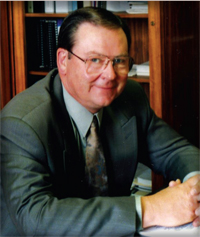Page Content
 Halvar Jonson is one of the few men to have been both a school principal and a minister of education, and the only ATA president to have served as education minister. His ministership coincided with turbulent times in education in this province, and he walked a fine line between his job as a politician and his education and experience as a teacher.
Halvar Jonson is one of the few men to have been both a school principal and a minister of education, and the only ATA president to have served as education minister. His ministership coincided with turbulent times in education in this province, and he walked a fine line between his job as a politician and his education and experience as a teacher.
Halvar Jonson was born in Athabasca, Alberta, on August 14, 1941. Armed with a B.Ed. from the University of Alberta, Jonson began his teaching career at Bentley High School, where he taught from 1963 to 1965. In 1966 he was appointed principal of Crestomere School, which is near Lacombe. A few years later, he moved to Ponoka Composite High School, where he served first as assistant principal and then as principal from 1980 to 1987. Along the way he also completed an M.Ed. and a graduate diploma in educational administration, both at the U of A.
Jonson was also active in the Association. He was first elected district representative for Central Western Alberta in 1971 and served in that position for three years. In 1974, he was elected vice-president of the Association; in 1976, he was elected president. He served one term as president and three as past president, retiring from Association politics in 1981, but not from politics altogether—in the 1982 provincial election, Jonson ran as a Progressive Conservative candidate for the riding of Ponoka and won. Because of the redrawing of electoral district boundaries, the riding of Ponoka was later abolished and re-created as Ponoka-Rimbey. Jonson ran for his second term in the new electoral district and won easily. In fact, Jonson was elected four more times, making for a total of six terms as MLA. In what must have been a gratifying result for him, in the 2001 Alberta general election, his last, he won by a landslide.
In his many years in government, Jonson held a number of portfolios: he was appointed minister of education in 1992 and held that position for three and a half years. His appointment as education minister coincided with Ralph Klein’s assumption of the premiership and what some characterized as a hard turn to the right. The so-called Klein Revolution lionized private enterprise as more efficient and effective than public institutions, and in the name of fiscal restraint and accountability, the government embarked on a program of severe and swift cutbacks that seriously worried Alberta’s professional educators. Jonson’s record as minister during the brutal 1990s is somewhat controversial. For some, Jonson’s 1994 education reforms were problematic, but when I asked current Association Executive Secretary Gordon Thomas about Jonson’s record, he suggested that the reforms to education would have been far more difficult and the funding cuts more severe if Jonson had not been education minister. Thomas went on to say that some of Jonson’s reforms—such as decentralized budgeting; the Teacher Growth, Supervision and Evaluation Policy; and amendments to the Teaching Profession Act that enhanced the Association’s discipline process—were good ones. Added Thomas: “He was the best minister we could have had at a very difficult time in history.”
Jonson was appointed health minister in 1995. He also later served as minister of the environment, and of international and intergovernmental relations. He retired from politics at the dissolution of the 2004 legislature.
In honour of his public service the provincial government renamed the brain injury ward of the Alberta Hospital Ponoka as the Halvar Jonson Centre for Brain Injury.
